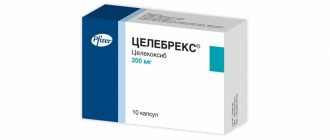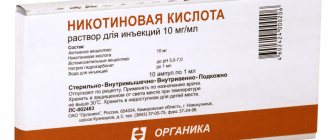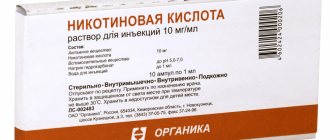Pharmacodynamics, pharmacokinetics
The task of the drug lies in regulating the metabolism of calcium and phosphorus. But in addition to this, the body is replenished with vitamin D3. Taking Vigantol promotes the mineralization of skeletal bones, which is very important for the normal functioning of the parathyroid glands.
Absorption of the drug occurs through the gastrointestinal tract. It has been proven that the active substance Vigantol can penetrate the placenta and enter breast milk.
Excretion of colecalciferol occurs mainly in the bile, and only a small part is excreted in the urine.
Vigantol oil solution for oral administration 0.5 mg/ml bottles, 10 ml
Manufacturer
Luzomedicamenta Sociedad Tecnica Pharmaceutica, Portugal
Compound
Active ingredient:
colecalciferol 500 mcg (20,000 IU)
Excipients:
medium chain triglycerides - 939.5 mg.
pharmachologic effect
The purpose of this drug is to regulate the metabolism of calcium and phosphorus. At the same time, vitamin D3 deficiency is compensated, calcium absorption in the gastrointestinal tract and phosphate reabsorption in the kidneys are enhanced. Vigantol also promotes bone mineralization, which is necessary for the parathyroid glands to function properly.
Absorption of the drug occurs from the gastrointestinal tract. Inside the body, the active substance binds to α2-globulins, some with albumins.
The accumulation of colecalciferol occurs in the liver, bone and adipose tissue, skeletal muscles, adrenal glands and kidneys, and myocardium. The maximum concentration of the substance in tissues is reached after 4-5 hours, then it decreases slightly, but still remains at the required level for a long time.
It has been established that colecalciferol penetrates the placental barrier and is also excreted in breast milk.
As a result of biotransformation in the liver and kidneys, inactive metabolites are formed - calcifediol and dihydroxycolecalciferol, the active metabolite calcitriol.
Indications
The main indications for the use of Vigantol are:
- rickets;
- spasmophilia;
- osteomalacia.
Contraindications
- hypercalcemia;
- hypercalciuria;
- calcium nephrourolithiasis;
- thyrotoxicosis (possibility of hypersensitivity);
- renal osteodystrophy with hyperphosphatemia;
- hypervitaminosis D;
- hypersensitivity to the components of the drug.
The drug should be prescribed with caution in case of atherosclerosis, heart failure, renal failure, sarcoidosis or other granulomatosis, hyperphosphatemia, phosphate nephrourolithiasis (including a history), organic heart damage, acute and chronic liver and kidney diseases, gastrointestinal diseases (including including gastric and duodenal ulcers), with hypothyroidism, during pregnancy and breastfeeding, when taking additional amounts of vitamin D3 (for example, as part of other medications).
Side effects
From the digestive system: constipation, flatulence, nausea, abdominal pain, diarrhea, loss of appetite.
Metabolism: hypercalcemia and hypercalciuria when taking the drug for a long time in high doses, polyuria.
From the musculoskeletal system: myalgia, arthralgia.
From the cardiovascular system: increased blood pressure, arrhythmias.
Allergic reactions: itching, rash, urticaria.
Other: headache, impaired renal function, exacerbation of tuberculosis in the lungs.
Interaction
Phenytoin, primidone and barbiturate drugs increase the need for vitamin D3 due to an increase in the rate of biotransformation. Long-term therapy with the simultaneous use of antacids containing aluminum and magnesium ions increases their concentration in the blood and the risk of intoxication (especially in the presence of chronic renal failure).
Calcitonin, bisphosphonates (including etidronic and pamidronic acid), plicamycin reduce the effect.
Cholestyramine and colestipol reduce the absorption of fat-soluble vitamins from the gastrointestinal tract and require an increase in their dose.
Increases the absorption of phosphorus-containing drugs and the risk of hyperphosphatemia.
When used simultaneously with sodium fluoride, the interval between doses should be at least 2 hours; with oral forms of tetracyclines - at least 3 hours.
With concomitant therapy with GCS, the effectiveness of the drug may be reduced.
Concomitant therapy with cardiac glycosides may increase their toxic potential due to the development of hypercalcemia. In such patients, it is necessary to monitor calcium levels, ECG, and adjust the dose of cardiac glycosides.
Concomitant therapy with benzodiazepine derivatives increases the risk of developing hypercalcemia.
Vitamin D3 can be combined with vitamin D metabolites or analogues only in exceptional cases and under the control of serum calcium levels.
Thiazide diuretics may reduce urinary calcium excretion and, accordingly, increase the risk of developing hypercalcemia. In such patients, it is necessary to constantly monitor the concentration of calcium in the blood.
Rifampicin and isoniazid may reduce the effect of the drug due to an increase in the rate of biotransformation.
Vigantol® does not interact with food.
How to take, course of administration and dosage
The drug Vigantol is taken orally with milk or other liquid.
Prevention of rickets: full-term healthy children are prescribed Vigantol® from the 2nd week of life, 1 drop (about 667 IU of vitamin D3) daily. Premature babies are prescribed 2 drops (1334 IU of vitamin D3) daily from the 2nd week of life. The drug should be taken during the first and second year of life, especially during the winter months.
Treatment of rickets: prescribe 2-8 drops of Vigantol (about 1334 - 5336 IU of vitamin D3) per day. Treatment should be continued for 1 year. Prevention of the risk of diseases associated with vitamin D3 deficiency: 1-2 drops (about 667-1334 IU of vitamin D3) per day. Prevention of vitamin D3 deficiency in malabsorption syndrome: 5-8 drops (about 3335-5336 IU of vitamin D3) per day.
Treatment of osteomalacia caused by vitamin D3 deficiency: 2-8 drops (about 1334-5336 IU vitamin D3) per day. Treatment should be continued for 1 year.
Maintenance therapy for osteoporosis: 2-5 drops of Vigantol (about 1334-3335 IU of vitamin D3) per day.
Treatment of hypoparathyroidism and pseudohypoparathyroidism: depending on the plasma concentration of calcium, 15-30 drops (about 10,005-20,010 IU of vitamin D3) are prescribed per day. Blood calcium levels should be checked within 4-6 weeks, then every 3-6 months, and the dose adjusted according to blood calcium levels.
Overdose
Symptoms of hypervitaminosis D3: early (due to hypercalcemia) - constipation or diarrhea, dry oral mucosa, headache, thirst, pollakiuria, nocturia, polyuria, anorexia, metallic taste in the mouth, nausea, vomiting, unusual fatigue, general weakness, adynamia, dehydration, hypercalcemia, hypercalciuria, increased plasma concentrations of 25-dihydrocolecalciferol; late - bone pain, cloudiness of urine (appearance of hyaline casts in the urine, proteinuria, leukocyturia), increased blood pressure, skin itching, photosensitivity of the eyes, conjunctival hyperemia, arrhythmia, drowsiness, myalgia, nausea, vomiting, pancreatitis, gastralgia, weight loss; rarely - changes in the psyche (up to the development of psychosis) and mood.
Symptoms of chronic overdose of vitamin D3 (when taken for several weeks or months for adults in doses of 20-60 thousand IU / day, for children - 2-4 thousand IU / day): calcification of soft tissues, kidneys, lungs, blood vessels, increased blood pressure, renal and heart failure (these effects most often occur when hyperphosphatemia is added to hypercalcemia), growth impairment in children (long-term use at a dose of 1.8 IU/day).
Treatment: in case of acute or chronic overdose, it is necessary to take measures to treat developing hypercalcemia. Depending on the severity of hypercalcemia, the following measures are used: discontinuation of the drug, a low-calcium diet, consumption of large amounts of fluid, administration of corticosteroids, vitamin E, ascorbic acid, retinol, thiamine, pantothenic acid, riboflavin; in severe cases - intravenous administration of 0.9% sodium chloride solution, furosemide, electrolytes, hemodialysis, administration of calcitonin. There is no specific antidote. To avoid overdose, in some cases it is recommended to determine the concentration of calcium in the blood.
Special instructions
With pseudohypoparathyroidism, it is necessary to monitor for signs of intoxication. Because with pseudohypoparathyroidism, there may be phases of normal sensitivity to vitamin D; it is necessary to adjust the dose of the drug.
In case of pseudohypoparathyroidism that occurs after surgical treatment of the thyroid gland, it is necessary to stop using the drug as the parathyroid glands are restored to prevent vitamin D intoxication.
Impact on the ability to drive vehicles and operate machinery
Studies on the effect on the ability to drive a vehicle and operate machinery have not been conducted.
Release form
oral solution
Active substance
Colecalciferol
Conditions for dispensing from pharmacies
On prescription
Dosage form
oral solution
Indications
Rickets, Malnutrition, Osteoporosis
Information in the State Register of Medicines
Go
Barcode and weight
Barcode: 4022536645971 Weight: 0.043 kg
Side effects
In some cases, taking the drug causes negative consequences:
- arrhythmia
- hypercalcemia
- hypercalciuria
- vomit
- nausea
- change of consciousness
- mental disorders
- urolithiasis
- weight loss
- thirst
- poor appetite
Vigantol for children: instructions
The annotation clearly states how to take Vigantol to newborn children. Usually the medicine is mixed in one spoon of milk or water.
To prevent rickets, healthy (full-term) babies are prescribed 1 drop of the drug per day. The medicine must be taken for 5 days. After this, you should stop using the medication for two weeks. One-year and two-year-old children do not need to take the product in the summer.
Premature newborns, starting from the 10th day of life, are prescribed 2 drops of the vitamin daily for 5 days, after which it is necessary to take a two-week break and start taking the drug again according to the above regimen.
For rickets, the doctor may prescribe from 2 to 8 drops of the drug.
General description:
Please note: previously (until September 2022) this drug was called Vigantoletten.
More information about the name change can be found here
Vigantol from Germany is No. 1 among vitamin D preparations in Europe! VIGANTOL 1000 IE has long been proven to prevent vitamin D deficiency and support the treatment of osteoporosis, as well as for the prevention of rickets in infants and children.
Did you know: to prevent vitamin D deficiency, in most cases it is already enough to take half a VIGANTOL ® 1000 IU tablet once a day?
- The drug is a vitamin supplement: it contains colecalciferol (equivalent to vitamin D3).
- Used: For the prevention of rickets in premature infants
- To prevent the risk of developing vitamin D deficiency in healthy people without resorption disorders (impaired absorption of vitamin D in the intestines)
- For the maintenance treatment of osteoporosis (bone degradation in older people)
Vigantol overdose
An overdose of the drug occurs due to the accumulation of excess D3 in the tissues.
In case of overdose, the following symptoms occur:
- headache
- anorexia
- diarrhea
- constipation
- metallic taste in mouth
- nausea and vomiting
- severe weakness
- hypertension
- arrhythmia
- myalgia
- conjunctival hyperemia
- joint or muscle pain
- change in urine color
If you have symptoms of overdose, you should:
- stop using the drug
- follow a low calcium diet
- drink plenty of fluids
- take vitamins E, C, thiamine, riboflavin
In some situations, IV will be required:
- 0.9% sodium chloride
- Calcitonin
- Electrolytes
- Furosemide
In some cases, hemodialysis is advisable.
Careful control over the amount of calcium in the body will help avoid hypervitaminosis.
Method of administration:
- Infants and Toddlers: Dissolve the tablet in a teaspoon of water or milk and pour the dissolved tablet directly into the child's mouth, preferably during meals.
- It is not recommended to add tablets to children's bottles or food, as this does not guarantee adequate intake of the vitamin into the body.
- When using fortified foods, it is necessary to take into account the amount of vitamin D it contains.
- Take the tablets with plenty of water.
Drug interactions
Pharmaceuticals primidone, medications included in the category of barbiturates increase the rate of biotransformation, which increases the requirement of vitamin D.
The combined use of Vigantol with bisphosphonates, calcitonin, plicamycin reduces the effectiveness of vitamin D3.
Combining the drug with glycosides and benzodiazepines, thiazide diuretics increases the risk of developing hypercalcemia.
The effectiveness of the drug decreases when combining it
isoniazid, rifampicin, since these drugs increase the biotransformation of the components of Vigantol.
A decrease in the effectiveness of this drug is observed with simultaneous treatment with rifampicin and isoniazid, as they increase the rate of biotransformation.
special instructions
If a person suffers from pseudohypoparathyroidism, then it is worth strictly monitoring the presence of overdose symptoms. This is explained by the fact that in pathology there are moments of normal sensitivity to the drug, so it is necessary to adjust the dosage of the vitamin. The drug should be stopped after the parathyroid glands begin to recover, otherwise poisoning will occur.
Unfortunately, no studies have been conducted on the effect of the drug on the ability to drive a car.
Data on the interaction of alcohol and drugs are not provided.
Pregnancy and breastfeeding:
- pregnancy Daily doses up to 500 IU/day There are currently no known risks within the indicated dose range.
- Long-term overdoses of vitamin D should be prevented during pregnancy, as the resulting hypercalcemia (increased concentration of calcium in the blood) can lead to physical and mental disability, as well as congenital heart and eye diseases in the child.
- During pregnancy, VIGANTOL 1000 IE vitamins should be taken only after strict instructions from a doctor and only take the dosage that is necessary to correct calcium deficiency
- Vitamin D and its metabolites pass into breast milk. An overdose produced in this way in an infant was not observed.









